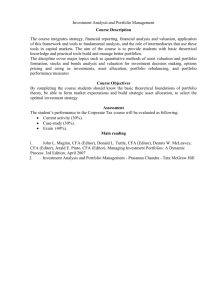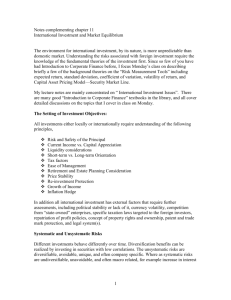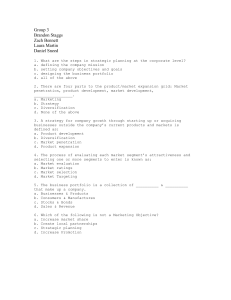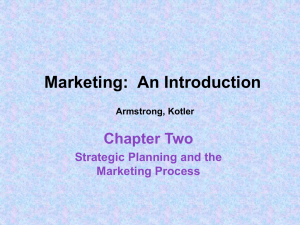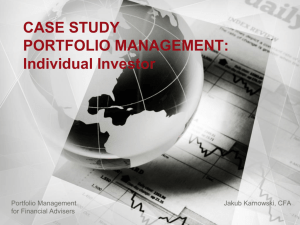Low * basis stock
advertisement
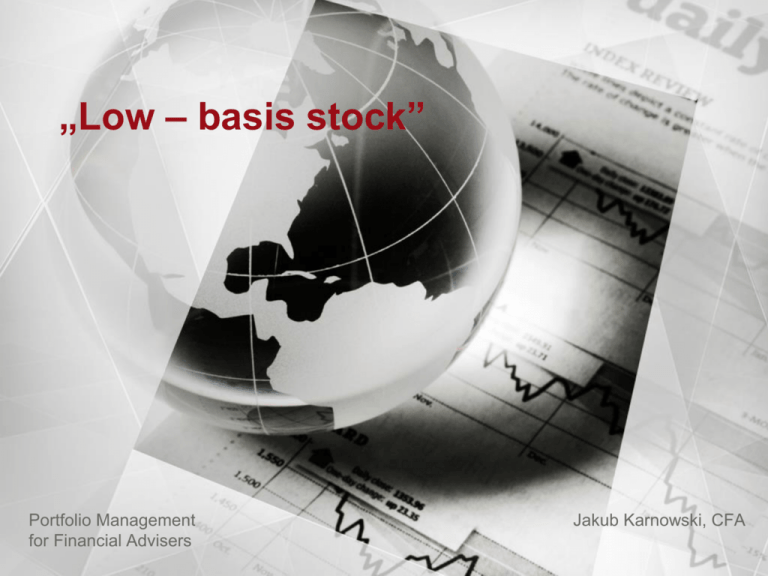
„Low – basis stock” Portfolio Management for Financial Advisers Jakub Karnowski, CFA Table of contents 1. Risk Associated with Stocks 2. Factors that affect the levels of diversification during each stage 3. Reducing a concentrated equity risk a) Outright Sales b) Exchange Funds c) Public Exchange Funds d) Completion Portfolios e) Hedging Strategies STOCK BASIS is a term primarily used for tax purposes stock in which you have a large gain in value is referred to as low-basis stock low basis implies that a particular stock has a significantly higher market value than its tax cost the basis of a stock represents the price that is used to calculate capital gain It is essential to understand how low basis stock is accumulated. This means by which low basis stock is accumulated can impact the way the investor views these investments and the willingness of the investor to sell at a future point in time Low basis stocks generally stem from: Entrepreneurial success Executive success Investment success Portfolio Management for Financial Advisers Jakub Karnowski, CFA 3 Risk Associated with Stocks Risk of any investment can be separated into two components: 1) 2) Market (systematic) risk - affects all securities in the same asset class Specific risk - is specific to a security and can be reduced by diversification Specific risk changes over different stages of „equity holding lives”: STAGE 1: ENTREPRENEURIAL Individual’s company is immature Individual holds essentially one security VERY HIGH SPECIFIC RISK STAGE 2: EXECUTIVE Individual’s company has been taken public HIGH BUT MODERATE SPECIFIC RISK STAGE 3: INVESTOR Individual moves away from the single into multi-security portfolio FURTHER DECLINE OF SPECIFIC RISK 4 Portfolio Management for Financial Advisers Jakub Karnowski, CFA Table of contents 1. Risk Associated with Stocks 2. Factors that affect the levels of diversification during each stage 3. Reducing a concentrated equity risk a) Outright Sales b) Exchange Funds c) Public Exchange Funds d) Completion Portfolios e) Hedging Strategies Factors that affect the levels of diversification during each stage Individual does not want diversification during this stage Entrepreneurs want maximum exposure to the upside potential their business has to offer ENTREPRENEURIAL STAGE Financial backers (venture capitalists) positively view this type of financial commitment The investor will diversify only if it benefits the business (for example: selling ownership in the business to obtain additional funding) EXECUTIVE STAGE The higher the level within the organization the individual is, the lower the tendency is to seek diversification Diversification may be affected by any restrictions over equity sales The individual is no longer in direct control over the company and has to think of the company as a financial investment INVESTOR STAGE Requires the individual to examine the company on a fundamental basis The individual needs to consider diversifying low basis holding in company Portfolio Management for Financial Advisers Jakub Karnowski, CFA 6 Table of contents 1. Risk Associated with Stocks 2. Factors that affect the levels of diversification during each stage 3. Reducing a concentrated equity risk a) Outright Sales b) Exchange Funds c) Public Exchange Funds d) Completion Portfolios e) Hedging Strategies Reducing a concentrated equity risk Methods for reducing a concentrated equity risk include: 1. Outright Sales 2. Exchange Funds 3. Public Exchange Funds 4. Completion Portfolios 5. Hedging Strategies Portfolio Management for Financial Advisers Jakub Karnowski, CFA 8 Reducing a concentrated equity risk OUTRIGHT SALES The simplest and most expensive mean to reduce exposure The individual receives the cash proceeds and no longer has any residual risk associated with owning the stock Generate realized capital gains, and thus the taxes EXCHANGE FUNDS • They are formed when a number of individual investors, each having different concentrated holdings, poll their assets together to form a fund • The goal is to create a diversified portfolio by combining the individual assets PUBLIC EXCHANGE FUNDS • The formation of the partnership allows the investors to achieve diversification goals without having to incur realized capital gains at the outset • At the end of partnership each partner will receive a proportionate distribution of the fund with proportional share of all components of the fund • The capital gains tax liabilities will be deferred but not eliminated • The disadvantages are management cost, lack of control and lack of flexibility Portfolio Management for Financial Advisers Jakub Karnowski, CFA 9 Reducing a concentrated equity risk COMPLETION PORTFOLIOS Allows the investor to create a portfolio that behaves like a stock index by combining the low basis stock with the investor’s other liquid assets. The other liquid assets are used to purchase a basket of stocks which would offset, or diversify, the risk of the single position. MAJOR DISADVANTAGES: It is suitable only for investors that already have a significant pool of other financial assets Diversification process takes time to develop, unless the low basis holding was already a small part of total holdings HEDGING STRATEGIES Involves finding a way to reduce or remove the downside risk related to a stock’s downward price movement. Hedging strategies have become the technique of choice for low basis diversification. TWO DISTINCT STEPS: The risk of the low basis holding is diversified Investor borrows against the value of the portfolio and in this way monetize an otherwise illiquid holding; the proceeds from borrowing are then invested and provide a hedge of the low basis position Portfolio Management for Financial Advisers Jakub Karnowski, CFA 10 THANK YOU! Portfolio Management for Financial Advisers Jakub Karnowski, CFA 11



